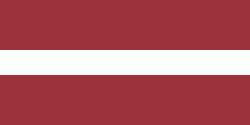Daugavgriva (Daugavgrīva)
In Vecdaugava, on the right or opposite side of the Daugava (German: Düna) outside the borders of the contemporary neighborhood, was in 1208 Dünamünde castle built by the Teutonic Knights, which initially served as a monastery. The Swedish fortress of Neumünde on the right bank, designed in a Dutch style by General Rothenburg in 1641, replaced the ruined Dünamünde Castle by 1680.
In 1695 the Commandant was captain Heinrich Nicolaus Rüdinger, forefather of future Patriarch Alexy II of Russia. Rüdinger was knighted by Charles XI of Sweden. Joachim Cronman later became the Commandant and he died on March 5, 1703.
After the fortress was seized by the Russians they reconstructed it. Regent Anna Leopoldovna of Russia, her husband Anthony Ulrich, and her son Ivan VI were incarcerated in Dünamünde in 1742.
A local Lutheran church was rebuilt into the Orthodox Church of the Saviour's Transfiguration in 1775.
The Russian government renamed the fortress, where only Russian soldiers were living, to Ust-Dvinsk in 1893. They had its fortifications completely reconstructed prior to World War I. During the war Ust-Dvinsk was bombarded by the Schütte-Lanz Airship SL 7 of the German Army. After the fortress was taken by Imperial Germany, it was inspected by Emperor Wilhelm II in 1917. The Latvian government, however, demolished much of the fortifications several years later. During the Cold War Ust-Dvinsk was a base for Soviet troops. The site is now known in Latvian as Daugavgrīva. There is a functional lighthouse at Daugavgrīva which was originally built in 1818. It was rebuilt in 1863, 1920, and after World War II.
In March 1942 took place the so called "Dünamünde Action". The Nazis informed the Judenrat of the ghetto of Riga that the people would go to a supposed town called Dünamünde to work at fish processing. Instead the people were taken by motor transport to Biķernieki forest, where they were shot and buried in common unmarked graves.
Map - Daugavgriva (Daugavgrīva)
Map
Country - Latvia
 |
 |
| Flag of Latvia | |
After centuries of Teutonic, Swedish, Polish-Lithuanian and Russian rule, which was mainly executed by the local Baltic German aristocracy, the independent Republic of Latvia was established on 18 November 1918 when it broke away from the German Empire and declared independence in the aftermath of World War I. However, by the 1930s the country became increasingly autocratic after the coup in 1934 establishing an authoritarian regime under Kārlis Ulmanis. The country's de facto independence was interrupted at the outset of World War II, beginning with Latvia's forcible incorporation into the Soviet Union, followed by the invasion and occupation by Nazi Germany in 1941, and the re-occupation by the Soviets in 1944 to form the Latvian SSR for the next 45 years. As a result of extensive immigration during the Soviet occupation, ethnic Russians became the most prominent minority in the country, now constituting nearly a quarter of the population. The peaceful Singing Revolution started in 1987, and ended with the restoration of de facto independence on 21 August 1991. Since then, Latvia has been a democratic unitary parliamentary republic.
Currency / Language
| ISO | Currency | Symbol | Significant figures |
|---|---|---|---|
| EUR | Euro | € | 2 |
| ISO | Language |
|---|---|
| LV | Latvian language |
| LT | Lithuanian language |
| RU | Russian language |















